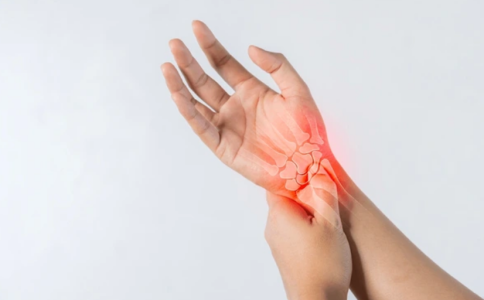Doctor unveils breakthrough treatment for common nerve condition
By
Gian T
- Replies 2
Suppose you’ve ever experienced tingling, numbness, or even pain in your hand or wrist, especially after a long day of gardening, knitting, or even scrolling on your phone.
In that case, you might be familiar with carpal tunnel syndrome. It’s a pesky condition that affects up to 6 per cent of adults, and for many, it can make everyday tasks feel like a real chore.
But some exciting news is on the horizon, and it’s coming straight from our backyard.
Dr Peter Hebbard, a specialist anaesthetist from Victoria, is leading the charge with a revolutionary new treatment that could change the way we manage this common nerve complaint.
Before we get into the nitty-gritty of this breakthrough, let’s quickly recap what carpal tunnel syndrome (CTS) actually is.
The carpal tunnel is a narrow passageway in your wrist, and the median nerve runs right through it.
When this tunnel gets compressed—often from repetitive hand movements, arthritis, or even just swelling the nerve gets squished, leading to those telltale symptoms: pain, tingling, numbness, and sometimes weakness in the hand.
CTS is especially common among people who use their hands a lot for work or hobbies.
Dr Hebbard notes, 'I see a lot of cooks, I see hairdressers'—but anyone can be affected, especially as we get older.
Traditionally, severe cases of carpal tunnel syndrome have been treated with open or endoscopic surgery, which involves cutting the ligament that’s pressing on the nerve.
While effective, these surgeries can require a hospital stay, a general anaesthetic, and a lengthy recovery period, not to mention the risks that come with any operation.
Enter Dr Hebbard’s micro-invasive procedure. He can precisely target the carpal tunnel ligament using a tiny needle and guided by external ultrasound.
Once the needle is in place (and after a local anaesthetic, so you won’t feel a thing), a small blade is deployed to cut the ligament and relieve the pressure on the nerve.
The whole thing can be done in a clinic, and you’re up and about much faster than with traditional surgery.
'It’s the convenience… we can do it in the clinic, it’s safer, and it’s got a quicker recovery,' Dr Hebbard explains.
And for those of us who’d rather not spend any more time in hospital waiting rooms than absolutely necessary, that’s music to our ears!
The best part is that Medicare partly covers this procedure, making it more accessible for everyday Aussies.
Currently, it’s available in Victoria and Queensland, but there are plans to expand to other states soon.
So, if you’re living elsewhere, keep your eyes peeled—help could be on the way!
As with any medical procedure, there are some risks involved, such as infection, bleeding, or nerve injury.
However, because this technique is minimally invasive and uses ultrasound guidance, the risks are generally lower than with traditional surgery.
Of course, it’s always important to have a thorough chat with your doctor about your options and what’s best for your individual situation.
Carpal tunnel syndrome can be particularly troublesome as we age, especially if you love your crafts, gardening, or even just want to keep up with the grandkids.
Quick, effective treatments that don’t require a long recovery are a real game-changer for maintaining independence and quality of life.
While this new procedure is a fantastic option for many, it’s not the only way to manage CTS. Here are a few other strategies that might help:

Have you struggled with carpal tunnel syndrome? What treatments have you tried, and what worked best for you? Would you consider this new micro-invasive procedure if it became available in your area? Share your stories, tips, and questions in the comments below.
Read more: ‘I will never have a thumbnail again’: Woman's shocking discovery after getting a manicure
In that case, you might be familiar with carpal tunnel syndrome. It’s a pesky condition that affects up to 6 per cent of adults, and for many, it can make everyday tasks feel like a real chore.
But some exciting news is on the horizon, and it’s coming straight from our backyard.
Dr Peter Hebbard, a specialist anaesthetist from Victoria, is leading the charge with a revolutionary new treatment that could change the way we manage this common nerve complaint.
Before we get into the nitty-gritty of this breakthrough, let’s quickly recap what carpal tunnel syndrome (CTS) actually is.
The carpal tunnel is a narrow passageway in your wrist, and the median nerve runs right through it.
When this tunnel gets compressed—often from repetitive hand movements, arthritis, or even just swelling the nerve gets squished, leading to those telltale symptoms: pain, tingling, numbness, and sometimes weakness in the hand.
CTS is especially common among people who use their hands a lot for work or hobbies.
Dr Hebbard notes, 'I see a lot of cooks, I see hairdressers'—but anyone can be affected, especially as we get older.
Traditionally, severe cases of carpal tunnel syndrome have been treated with open or endoscopic surgery, which involves cutting the ligament that’s pressing on the nerve.
While effective, these surgeries can require a hospital stay, a general anaesthetic, and a lengthy recovery period, not to mention the risks that come with any operation.
Enter Dr Hebbard’s micro-invasive procedure. He can precisely target the carpal tunnel ligament using a tiny needle and guided by external ultrasound.
Once the needle is in place (and after a local anaesthetic, so you won’t feel a thing), a small blade is deployed to cut the ligament and relieve the pressure on the nerve.
The whole thing can be done in a clinic, and you’re up and about much faster than with traditional surgery.
'It’s the convenience… we can do it in the clinic, it’s safer, and it’s got a quicker recovery,' Dr Hebbard explains.
And for those of us who’d rather not spend any more time in hospital waiting rooms than absolutely necessary, that’s music to our ears!
The best part is that Medicare partly covers this procedure, making it more accessible for everyday Aussies.
Currently, it’s available in Victoria and Queensland, but there are plans to expand to other states soon.
So, if you’re living elsewhere, keep your eyes peeled—help could be on the way!
As with any medical procedure, there are some risks involved, such as infection, bleeding, or nerve injury.
However, because this technique is minimally invasive and uses ultrasound guidance, the risks are generally lower than with traditional surgery.
Of course, it’s always important to have a thorough chat with your doctor about your options and what’s best for your individual situation.
Carpal tunnel syndrome can be particularly troublesome as we age, especially if you love your crafts, gardening, or even just want to keep up with the grandkids.
Quick, effective treatments that don’t require a long recovery are a real game-changer for maintaining independence and quality of life.
While this new procedure is a fantastic option for many, it’s not the only way to manage CTS. Here are a few other strategies that might help:
- Wrist splints: Wearing a splint at night can keep your wrist neutral and reduce symptoms.
- Lifestyle changes: Taking breaks from repetitive tasks, stretching, and ergonomic adjustments can make a big difference.
- Medications: Anti-inflammatories or corticosteroid injections can help reduce swelling and pain.
- Physical therapy: Special exercises can sometimes help relieve pressure on the nerve.
Key Takeaways
- A Victorian doctor has developed a micro-invasive procedure using guided ultrasound to treat carpal tunnel syndrome, offering a new alternative to traditional surgery.
- The treatment involves inserting a needle into the wrist under local anaesthetic, with a small blade cutting the carpal tunnel ligament to relieve pressure on the median nerve.
- The procedure can be done in a clinic, is considered safer, allows for quicker recovery compared to standard surgery, and is partly covered by Medicare.
- Currently, the treatment is available in Victoria and Queensland, with plans to expand to more states, but patients are reminded that, like all medical procedures, there are some risks involved.
Read more: ‘I will never have a thumbnail again’: Woman's shocking discovery after getting a manicure








